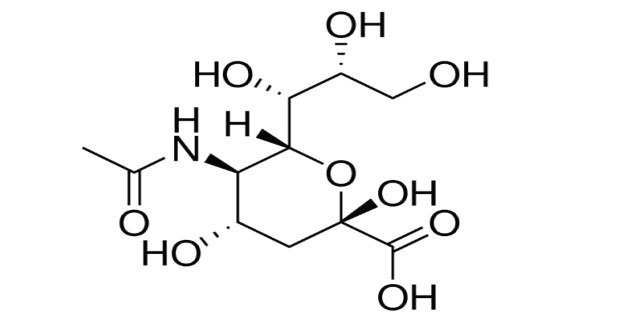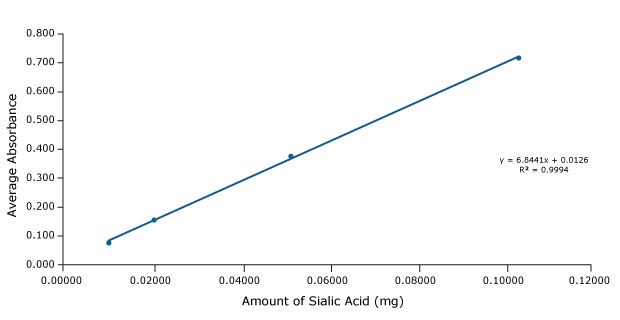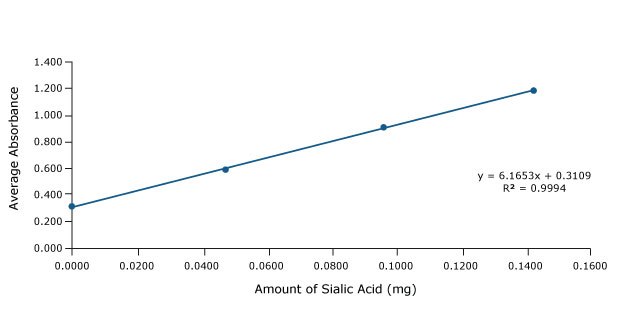Determination of Sialic Acid in Milk as a Marker for Adulteration with Whey
Eddy Tan, Associate Senior Scientist
R&D APAC Lab (Singapore)
INTRODUCTION
The food industry worldwide is required to demonstrate food authenticity and the quality control of milk is one example. Unethical producers can add nitrogen-rich compounds to correct the milk protein content. Adulteration of dairy milk with cheese whey can reduce its production cost significantly (4 to 5 times). Cheese whey does not change the sensory perception nor adversely affects health1. Another common milk adulterant is sweet whey2.
Glycomacropeptide (GMP) is a casein peptide found in dairy products like cheese whey. GMP is released in whey by rennet during cheese making. GMP is rich in sialic acid and this compound can therefore be used as an indicator to determine the adulteration of milk by whey.
The detection of adulterated milk is based on the detection of sialic acid bound in whey. This determination was carried out in 2 stages:
- Quantify the amount of sialic acid in the whey powder
- Quantify the amount of sialic acid in dairy milk by the standard addition method using the bovine whey powder from stage 1
GMP is first precipitated with trichloroacetic acid and phosphotungstic acid. Sialic acid is released from GMP and derivatized with the acidic ninhydrin method3 with the spectrophotometric measurement at 470 nm.

Figure 1. Structure of a sialic acid (N-acetylneuraminic acid).
EXPERIMENTAL METHOD
The standard addition method was chosen as milk can be a highly variable matrix – dependent on the source origin and processing employed. In addition, milk can be classified by different amounts of fat (full fat, skim milk, half and half), type of heat treatment (pasteurization, extended shelf life treatment, ESL, ultra-high temperature, UHT), and also the additives used (fortified with vitamins, etc.).
Cheese whey was not available locally so bovine whey was used instead.
Both the Spectroquant® Prove 100 and Prove 600 spectrophotometers were used for measurements.
Milk Samples
Three brands of dairy milk that are locally popular were selected:
- Brand 1 (from Denmark)
- Brand 2 (from Singapore)
- Brand 3 (from Thailand)
EXPERIMENTAL PROCEDURE
1. Standard Preparation for External Calibration Curve
- Sialic acid standard stock solution (~1000 mg/L)
- Weigh ~10 mg of the sialic acid analytical standard into a 10 mL volumetric flask
- Add ~6 mL of water into the flask and mix to dissolve completely
- Top up to mark and mix well before use. This is the 1000 mg/L sialic acid stock solution
- Prepare calibration standards in 15 mL centrifuge tubes from the stock solution of 1000 mg/L as in Table 1.
- See step 6 “Hydrolysis of GMP and derivatization of released sialic acid” for further steps
2. Reagent Preparation
- 0.1 M Sodium chloride pH 6.84: Weigh ~585 mg of sodium chloride into a 100 mL volumetric flask and dissolve it in 95 mL of water. Adjust pH to ~6.8 ±0.05 using 0.1 M hydrochloric acid or 0.1 M sodium hydroxide. Top up to mark with water.
- 240 g/L Trichloroacetic acid: Weigh ~7.2 g of trichloroacetic acid into a 100 mL glass bottle. Measure 30 mL of water using a measuring cylinder and add to the glass bottle. Mix well.
- 200 g/L Phosphotungstic acid: Weigh ~2 g of phosphotungstic acid into a 25 mL glass bottle. Measure 10 mL of water using a measuring cylinder and add to the glass bottle. Mix well.
- Derivatization reagent: Weigh ~375 mg of ninhydrin into a 25 mL glass bottle and protect it from light with aluminum foil. Add 6 mL fuming 37% hydrochloric acid followed by 9 mL glacial acetic acid. Cap tightly and mix contents for 30 to 40 min on an orbital shaker.
- Ethanol:Water solution (95:5): With a 100 mL measuring cylinder, measure out 95 mL of ethanol. With a 10 mL measuring cylinder, measure out 5 mL of water. Pour both solvents into a 100 mL glass bottle and mix well.
**All reagents need to be freshly prepared on the day of use
3. Standard addition– Spiking of bovine whey powder in milk
- Weigh bovine whey powder into 50 mL centrifuge tubes according to Table 2. Record mass used.
- For the tube marked “Reagent blank”, add 8 mL of water to the centrifuge tube
- For the tube marked “Whey only”, pipette 8 mL of 0.1 M NaCl into the centrifuge tube
- For tubes marked Std Add 1 to Std Add 4, pipette 8 mL of milk into each centrifuge tube
- Mix well for all tubes and sonicate for 10 min
4. Precipitation and removal of milk solids
- Pipette 4 mL of 240 g/L trichloroacetic acid into each of the tubes from above and cap tightly
- Vortex or vigorously shake tubes for 10 seconds
- Allow the samples to stand at room temperature for 30 mins
- Vortex or vigorously shake tubes for 5 seconds
- Centrifuge sample tubes for 5 minutes at 7000 g
- Filter samples via 0.45 µm hydrophilic PTFE filter into a new 15 mL centrifuge tube
5. Precipitation and washing of Glycomacropeptide (GMP)
- Pipette 1.2 mL of 200 g/L phosphotungstic acid into each tube from 4.6.
- Vortex or vigorously shake the tube for 10 s
- Centrifuge sample tubes for 10 min at 7000 g
- Discard the supernatant and take care not to remove the sediment
- Pipette 5 mL of 95:5 ethanol:water solution into each tube
- Vortex or vigorously shake the tube for 10 seconds to redisperse precipitates (some precipitates will stick to the bottom tube wall)
- Ultrasonicate contents for 5 min to completely disperse precipitates (this step can be repeated to break down big particulates.)
- Centrifuge sample tubes for 10 min at 7000 g
- Carefully discard the supernatant and take care not to remove the sediment
- Repeat steps 4. to 8. for a second round of washing
6. Hydrolysis of GMP and derivatization of released sialic acid
- Pre-heat a water bath at 100 oC
- Wrap centrifugation tubes with aluminum foil to protect them from light
- Pipette 2 mL of glacial acetic acid into the 15 mL centrifuge tubes (external standards, reagent blank, whey only, and samples)
- Pipette 1 mL of acidic ninhydrin into the same tube and cap tightly
- Vortex or vigorously shake the tube for 10 s
- Ultrasonicate samples in a water bath for 5 min (this step can be repeated to break down big particulates)
- Remove the aluminum foil, vigorously shake tubes, and heat samples at 100 oC water bath for 10 min
- Remove tubes from the water bath (HOT!!), shake well, and cool down with room temperature water for 5 min
7. VIS Spectrophotometric measurement
- Set the spectrophotometer to the wavelength of 470 nm for measurement and zero with Zero Cells.
- Transfer the reagent blank into a 1 cm glass cuvette in the fume hood (fumes!)
- Tap the cuvette gently to remove air bubbles if any are present
- Wipe down cuvette sides with KimWipes and insert them into the sample chamber of the spectrophotometer
- Zero spectrophotometer with reagent blank
- Drain the reagent blank into a waste beaker
- Rinse the cuvette with a small volume of a sample before filling the cuvette
- Measurement of samples can be based according to increasing spiked whey concentration
- Record the sample absorbance measurements

Figure 2. External calibration curve for-Sialic acid.
From the plot, the sialic acid content in 50.18 mg bovine whey is calculated using the equation:
y = 6.8441x + 0.0126
x = (0.337-0.0126)/6.8441 = 0.0473 mg sialic acid
This represents a sialic acid concentration in bovine whey of 0.00094 mg/mg.
Sialic Acid in Milk (Standard Addition with Bovine Whey)
“Brand 1” Milk by Spectroquant® Prove 600
The amount of sialic acid in bovine whey as determined earlier is 0.00094 mg per mg bovine whey

Figure 3.Standard calibration curve- Bovine whey in Brand 1 milk
From the standard addition plot, we have the equation
y = 6.1653x + 0.3109
We set y = 0 and solve for x.
x= |-0.3109/6.1653|
x = 0.05043 mg of sialic acid and this is from 8 mL of milk.
This represents a sialic acid concentration in the milk of 6.30 mg/L.
Determination of Sialic Acid in 3 Milk Brands (Standard Addition of Sialic acid using Bovine Whey)
The correlation of milk adulteration to its sialic acid content3 is classified in the following categories:*
From our results, all three milk brands are in the “Suspected” category.
*It is however important to note that the sialic acid content is affected by many parameters – one being the breed of dairy cows.2 Therefore, the defined categories above should be taken as guidance only.
CONCLUSION
The procedure described here is a modified version of the method published by Fukuda SP et.al. 20043 and allows the determination of sialic acid in bovine milk. It offers a practical alternative to screen for Glycomacropeptide (GMP) content.
See more applications for photometry and reflectrometry at SigmaAldrich.com/wfa-applications
References
如要继续阅读,请登录或创建帐户。
暂无帐户?